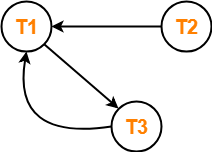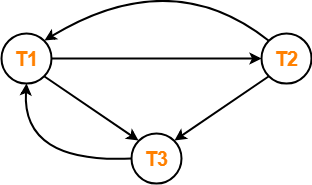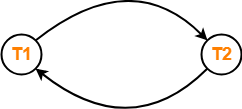View Serializability-
Before you go through this article, make sure that you have gone through the previous article on View Serializability.
We have discussed-
- The concept of serializability helps to identify the correct non-serial schedules that will maintain the consistency of the database.
- There are two types of serializability-

In this article, we will discuss practice problems based on view serializability.
Also read- Conflict Serializability
PRACTICE PROBLEMS BASED ON VIEW SERIALIZABILITY-
Problem-01:
Check whether the given schedule S is view serializable or not-

Solution-
- We know, if a schedule is conflict serializable, then it is surely view serializable.
- So, let us check whether the given schedule is conflict serializable or not.
Checking Whether S is Conflict Serializable Or Not-
Step-01:
List all the conflicting operations and determine the dependency between the transactions-
- W1(B) , W2(B) (T1 → T2)
- W1(B) , W3(B) (T1 → T3)
- W1(B) , W4(B) (T1 → T4)
- W2(B) , W3(B) (T2 → T3)
- W2(B) , W4(B) (T2 → T4)
- W3(B) , W4(B) (T3 → T4)
Step-02:
Draw the precedence graph-

- Clearly, there exists no cycle in the precedence graph.
- Therefore, the given schedule S is conflict serializable.
- Thus, we conclude that the given schedule is also view serializable.
Problem-02:
Check whether the given schedule S is view serializable or not-

Solution-
- We know, if a schedule is conflict serializable, then it is surely view serializable.
- So, let us check whether the given schedule is conflict serializable or not.
Checking Whether S is Conflict Serializable Or Not-
Step-01:
List all the conflicting operations and determine the dependency between the transactions-
- R1(A) , W3(A) (T1 → T3)
- R2(A) , W3(A) (T2 → T3)
- R2(A) , W1(A) (T2 → T1)
- W3(A) , W1(A) (T3 → T1)
Step-02:
Draw the precedence graph-

- Clearly, there exists a cycle in the precedence graph.
- Therefore, the given schedule S is not conflict serializable.
Now,
- Since, the given schedule S is not conflict serializable, so, it may or may not be view serializable.
- To check whether S is view serializable or not, let us use another method.
- Let us check for blind writes.
Checking for Blind Writes-
- There exists a blind write W3 (A) in the given schedule S.
- Therefore, the given schedule S may or may not be view serializable.
Now,
- To check whether S is view serializable or not, let us use another method.
- Let us derive the dependencies and then draw a dependency graph.
Drawing a Dependency Graph-
- T1 firstly reads A and T3 firstly updates A.
- So, T1 must execute before T3.
- Thus, we get the dependency T1 → T3.
- Final updation on A is made by the transaction T1.
- So, T1 must execute after all other transactions.
- Thus, we get the dependency (T2, T3) → T1.
- There exists no write-read sequence.
Now, let us draw a dependency graph using these dependencies-

- Clearly, there exists a cycle in the dependency graph.
- Thus, we conclude that the given schedule S is not view serializable.
Problem-03:
Check whether the given schedule S is view serializable or not-

Solution-
- We know, if a schedule is conflict serializable, then it is surely view serializable.
- So, let us check whether the given schedule is conflict serializable or not.
Checking Whether S is Conflict Serializable Or Not-
Step-01:
List all the conflicting operations and determine the dependency between the transactions-
- R1(A) , W2(A) (T1 → T2)
- R2(A) , W1(A) (T2 → T1)
- W1(A) , W2(A) (T1 → T2)
- R1(B) , W2(B) (T1 → T2)
- R2(B) , W1(B) (T2 → T1)
Step-02:
Draw the precedence graph-

- Clearly, there exists a cycle in the precedence graph.
- Therefore, the given schedule S is not conflict serializable.
Now,
- Since, the given schedule S is not conflict serializable, so, it may or may not be view serializable.
- To check whether S is view serializable or not, let us use another method.
- Let us check for blind writes.
Checking for Blind Writes-
- There exists no blind write in the given schedule S.
- Therefore, it is surely not view serializable.
Alternatively,
- You could directly declare that the given schedule S is not view serializable.
- This is because there exists no blind write in the schedule.
- You need not check for conflict serializability.
Problem-04:
Check whether the given schedule S is view serializable or not. If yes, then give the serial schedule.
S : R1(A) , W2(A) , R3(A) , W1(A) , W3(A)
Solution-
For simplicity and better understanding, we can represent the given schedule pictorially as-

- We know, if a schedule is conflict serializable, then it is surely view serializable.
- So, let us check whether the given schedule is conflict serializable or not.
Checking Whether S is Conflict Serializable Or Not-
Step-01:
List all the conflicting operations and determine the dependency between the transactions-
- R1(A) , W2(A) (T1 → T2)
- R1(A) , W3(A) (T1 → T3)
- W2(A) , R3(A) (T2 → T3)
- W2(A) , W1(A) (T2 → T1)
- W2(A) , W3(A) (T2 → T3)
- R3(A) , W1(A) (T3 → T1)
- W1(A) , W3(A) (T1 → T3)
Step-02:
Draw the precedence graph-

- Clearly, there exists a cycle in the precedence graph.
- Therefore, the given schedule S is not conflict serializable.
Now,
- Since, the given schedule S is not conflict serializable, so, it may or may not be view serializable.
- To check whether S is view serializable or not, let us use another method.
- Let us check for blind writes.
Checking for Blind Writes-
- There exists a blind write W2 (A) in the given schedule S.
- Therefore, the given schedule S may or may not be view serializable.
Now,
- To check whether S is view serializable or not, let us use another method.
- Let us derive the dependencies and then draw a dependency graph.
Drawing a Dependency Graph-
- T1 firstly reads A and T2 firstly updates A.
- So, T1 must execute before T2.
- Thus, we get the dependency T1 → T2.
- Final updation on A is made by the transaction T3.
- So, T3 must execute after all other transactions.
- Thus, we get the dependency (T1, T2) → T3.
- From write-read sequence, we get the dependency T2 → T3
Now, let us draw a dependency graph using these dependencies-

- Clearly, there exists no cycle in the dependency graph.
- Therefore, the given schedule S is view serializable.
- The serialization order T1 → T2 → T3.
Next Article- Recoverable and Irrecoverable Schedules
Get more notes and other study material of Database Management System (DBMS).
Watch video lectures by visiting our YouTube channel LearnVidFun.









